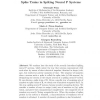Free Online Productivity Tools
i2Speak
i2Symbol
i2OCR
iTex2Img
iWeb2Print
iWeb2Shot
i2Type
iPdf2Split
iPdf2Merge
i2Bopomofo
i2Arabic
i2Style
i2Image
i2PDF
iLatex2Rtf
Sci2ools
IJFCS
2006
2006
Spike Trains in Spiking Neural P Systems
We continue here the study of the recently introduced spiking neural P systems, which mimic the way that neurons communicate with each other by means of short electrical impulses, identical in shape (voltage), but emitted at precise moments of time. The sequence of moments when a neuron emits a spike is called the spike train (of this neuron); by designating one neuron as the output neuron of a spiking neural P system , one obtains a spike train of . Given a specific way of assigning sets of numbers to spike trains of , we obtain sets of numbers computed by . In this way, spiking neural P systems become number computing devices. We consider a number of ways to assign (code) sets of numbers to (by) spike trains, and prove then computational completeness: the computed sets of numbers are exactly Turing computable sets. When the number of spikes present in the system is bounded, a characterization of semilinear sets of numbers is obtained. A number of research problems is also formulated....
| Added | 12 Dec 2010 |
| Updated | 12 Dec 2010 |
| Type | Journal |
| Year | 2006 |
| Where | IJFCS |
| Authors | Gheorghe Paun, Mario J. Pérez-Jiménez, Grzegorz Rozenberg |
Comments (0)

